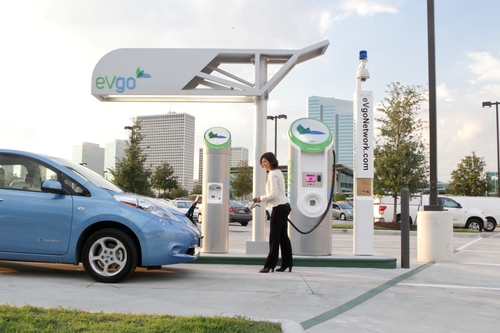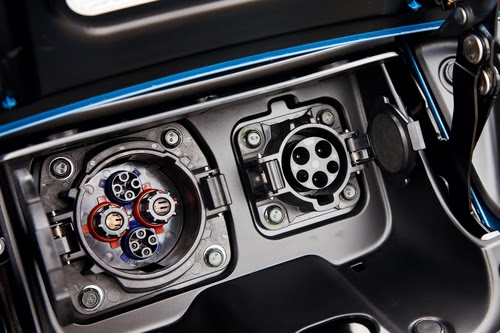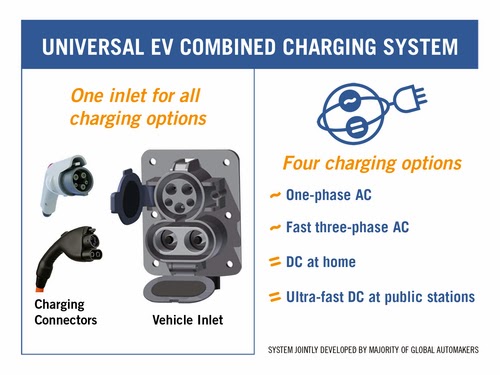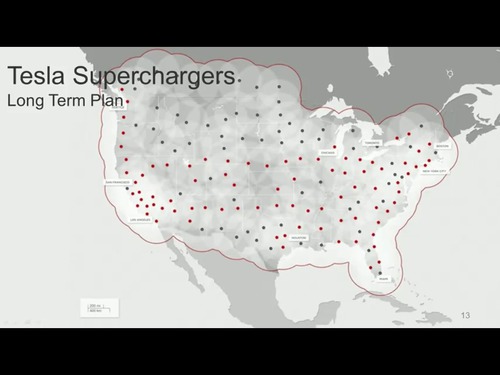In California, eVgo is beginning to build their charging infrastructure (finally – aren’t they a little behind schedule?) and the good news for BMW i3 and Chevy Spark EV owners is the infrastructure being built supports both CHAdeMO and Combo Charging System fast charging. But the situation just picks at a scab that’s covering a wound in the electric car charging field, a wound caused by bickering between carmakers on charging standards.
According to PlugInCars, eVgo now has 13 fast charging stations (a.k.a. Freedom Stations) operating in California.![]() As we reported before, the settlement between NRG and the California PUC that ushered eVgo into California requires that eVgo build out over 200 Freedom Stations within four years of late 2012 (when the settlement was finalized). I haven’t checked, but I think they’re a bit behind schedule.
As we reported before, the settlement between NRG and the California PUC that ushered eVgo into California requires that eVgo build out over 200 Freedom Stations within four years of late 2012 (when the settlement was finalized). I haven’t checked, but I think they’re a bit behind schedule.
The agreement also called for deploying dual-protocol fast charging stations, as soon as the DCQC makers start supplying dual protocol stations. A couple DCQC makers are now doing so.
There are some who see this as a negative result, coming because of the efforts by some automakers to, supposedly, use the SAE committee process to undermine the potential for CHAdeMO based DC Quick Charge and therefore undermine Nissan’s chance for success with the Leaf. The Leaf has been successful anyway, having now sold over 100,000 copies worldwide. But if there had been widespread CHAdeMO infrastructure in the U.S. by now, it’s arguably very likely that a lot more Leaf’s would have been sold in the U.S. by now.
What we have in the electric car DC Quick Charge arena is a three-way tug of war between different clumps of automakers.
The Nissan Leaf charging inlet represents one camp. Here we have two charging ports, one supporting a J1772 outlet for AC Level 2 charging, and one supporting CHAdeMO for DC Fast Charging, which is known as DC Level 2 (SAE Electric Vehicle Charging Levels![]() ).
).
At AC Level 2 you get 25 miles of range per hour of charging, and at DC Level 2 the implementation shown here gives the driver about 100 miles of range per hour of charging. I think. However, that’s gotten in 1/2 hour bursts because the Leaf battery pack is so small it only supports 60ish miles of range via CHAdeMO. With about 78 miles of range total the Leaf simply won’t be comfortable on road trips, though it can be done.
Mitsubishi also supports CHAdeMO in the i-MiEV. The standard was developed in Japan, and first deployed in 2008. Research presented by Mr. Anagawa of TEPCO during 2010![]() demonstrated that the simple presence of CHAdeMO fast chargers in Japan increased the utilization rate of electric cars dramatically.
demonstrated that the simple presence of CHAdeMO fast chargers in Japan increased the utilization rate of electric cars dramatically.
This is the second camp, the Combined Charging System developed through the SAE J1772 committee. It’s what some deride as the Frankenplug, because it takes a normal J1772 outlet and slaps on a pair of big pins for handling large DC currents.
The SAE committee was dominated by GM, Daimler, and other American and German automakers.
Other than the Chevy Volt, these companies have not yet shown a successful electric car, while Nissan has definitely been successful with the Leaf.
It is only now that cars with the CCS charging socket have come on the market – the BMW i3 and Chevy Spark EV, that we mentioned earlier. Both of those cars will be sold in small quantities (in the U.S.) only, and only in limited states within the U.S. We’re going to avoid detouring into the “compliance car” rathole but the point is the relative quantity of CCS-compatible and CHAdeMO-compatible cars in the U.S.
For the foreseeable future the quantity of CCS cars will be approximately zero, while the quantity of CHAdeMO cars in the U.S. is large (all the Nissan Leaf’s) and growing rapidly thanks to the 2000 or so Leaf’s sold per month.
Tesla Motors took a very different approach than all the other automakers. Where the current crop of CHAdeMO and CCS DCQC’s are 50 kilowatts, Tesla’s SuperCharger today supports 120 kilowatts. That equates out to nearly 300 miles of driving range per hour of charging. Couple that with a 250 mile range per charge, and the Tesla Model S is an entirely different animal than the Nissan Leaf.
Where the other automakers are building electric cars for use around town, Tesla Motors wanted to blow up stereotypes and build a no-compromise electric car.
Along the way, Tesla is building their own network of charging stations, as shown here, and just last week they finished building the first route across the U.S. Almost immediately a couple took a road trip being the first to cross the U.S. on free electricity, and they did it essentially as fast as any normal road trip.
It meant developing a Tesla-proprietary charging plug, and building an infrastructure that only supports Tesla’s cars.
Like the CHAdeMO DCQC protocol, the number of Tesla SuperCharger compatible cars is growing at about 2000 per month.
This means the growth rate for DCQC protocols in the U.S. is approximately –
- CHAdeMO: 2k/month
- SuperCharger: 2k/month
- CCS: close to 0 per month
The relative growth rate elsewhere is a little different. In Japan it’s almost entirely CHAdeMO because that’s the only DCQC standard being deployed, for example.
Further, the rates of both CHAdeMO and SuperCharger are expected to grow. Both Nissan and Tesla are working hard to eliminate barriers to increasing production rates. Over in the CCS camp, the automakers are still in the phase of selling compliance cars in small quantities in limited areas.
In other words, it appears that CHAdeMO and/or SuperCharger will remain strong as a de-facto standard for electric car fast charging for the foreseeable future.
The other automakers may be planning a large assault on the electric car market. They keep showing interesting concept cars, and selling nice compliance cars, while demonstrating a reluctance to take the bull by the horns as Nissan and Tesla have done.
Legally speaking the other automakers established CCS as the SAE Standard. Theoretically that means the automakers should adopt CCS because it’s the standard. At least that’s the argument General Motors has pushed.
But what’s actually occurring is a battle of numbers – As we see, the sales rate for different charging protocols is heavily skewed to CHAdeMO and SuperCharger, and remain this way for a long time.
How many CHAdeMO/SuperCharger cars will be on the road by the time other automakers begin selling significant quantities of CCS-compatible electric cars? It’s hard to say, but given the CCS camp is not making any significant effort, and their electric car efforts may remain low-key for several years, it means the CHAdeMO/SuperCharger camp will have a large lead.
Will CHAdeMO/SuperCharger become cemented in the marketplace by sheer weight of total sales?
On the other hand, having multiple charging protocols is suboptimal. It’s desirable for there to be one fast charging protocol, just like the single standard for gasoline fuel nozzles have been hugely successful for gasoline powered cars.
Maybe all these will be supplanted by something else?
- Highway design could decrease death and injury risk, if “we” chose smarter designs - March 28, 2015
- GM really did trademark “range anxiety”, only later to abandon that mark - March 25, 2015
- US Government releases new regulations on hydraulic fracturing, that some call “toothless” - March 20, 2015
- Tesla Motors magic pill to solve range anxiety doesn’t quite instill range confidence - March 19, 2015
- Update on Galena IL oil train – 21 cars involved, which were the supposedly safer CP1232 design - March 7, 2015
- Another oil bomb train – why are they shipping crude oil by train? – Symptoms of fossil fuel addiction - March 6, 2015
- Chevron relinquishes fracking in Romania, as part of broader pull-out from Eastern European fracking operations - February 22, 2015
- Answer anti- electric car articles with truth and pride – truth outshines all distortions - February 19, 2015
- Apple taking big risk on developing a car? Please, Apple, don’t go there! - February 16, 2015
- Toyota, Nissan, Honda working on Japanese fuel cell infrastructure for Japanese government - February 12, 2015

















